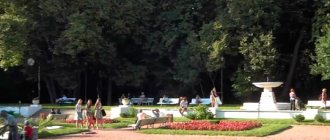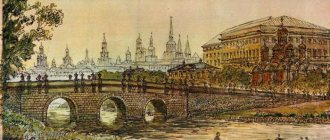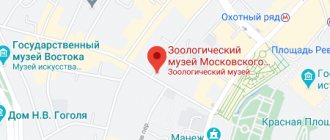From the beginning of the first somewhat warm days until the end of September, and if you’re lucky, until late autumn, people dance at the main capital’s venues almost every evening. Everything happens simply, without unnecessary fuss, and today it seems to come naturally: people appear, they start it up and it begins. Sometimes they even dance to their own music - drums, flash drive, whoever is rich in what.
In this format, the main dance floors in the city operate for free. If we are talking about summer dance schools, which, in particular, organize training master classes and parties here, you will still have to pay.
Gorky Park: salsa/bachata/lindy hop/country dance
Styles: salsa/bachata/lindy hop/country dance, etc.
When you can dance: every evening on weekdays, until the morning on weekends.
Address: Pushkinskaya embankment.
Admission: special parties and master classes – $; the rest of the time - free.
Perhaps the most famous open area for dancing in the capital. So much so that Foursquare lists it as “Dance Embankment”. But people simply call it “Boards”, and the actions taking place on the “Boards” are called “Bridges”. By the way, from 1922 to 1937 Pushkinskaya Embankment was officially Neskuchnaya.
The next season at “Boards” has already opened; people dance on the embankment until late at night, and sometimes until the morning. Everybody dance. From salsa and rock and roll to country dance and Lindy hop. Anyone can come, you can choose a partner right on the spot. The atmosphere is friendly, the circle of dancers is of a wide range of ages.
About Moscow “bridges”
The salsa open in Moscow's Gorky Park is perhaps the oldest in the country, as it has existed for almost fifteen years. He is, without a doubt, one of the most numerous.
Over the years, the Moscow “bridge” became the subject of heated debate.
With the organizers of different years, we talk about the past and present: music, dance and current problems.
Alexey Aleksentsev: how it all began - and beyond
— How did the idea of “bridges” come about?
At first there was a general thought - about dancing in the street. Firstly, simply because it is hot in the summer. Secondly, the guys and I were walking somewhere, and I saw how much they transformed when people looked at them.
We stood, danced something, unfamiliar girls passed by - and the guys suddenly cheered up. And I thought that in this way you can raise not even the level - style, attitude, tumbao.
“The Bridge” was definitely not intended as an advertisement, because at that time we didn’t need advertising, and we didn’t even really need it - the halls were jam-packed. It was 2001.
— What did the event look like at the very beginning?
At first, the “bridges” were set up simply: we took a boombox, inserted ten batteries into it and turned on the disk that we had. That's all.
There were no DJs - just a disc playing. Then our guys dabbled: they made several collections “Own School” - and played them.
The whole time I was working on the bridges, I was playing a boombox – such a round one, JVC. Only subsequent organizers were awarded some speakers and other equipment. But they also had many more people. And in the beginning there were no DJs, nothing.
And it wasn’t even a party—a meeting of “My School.” Well, then people began to slowly catch up. There were no drastic changes in the composition during my time. It’s just that when the presenter changes, the mood changes, and so does everything else.
I directed “Bridges” for probably five years – I didn’t specifically count it. Then I got tired. It’s just that when you spend your weekends away from home for many years... After all, I have a family - a wife, a child, over time, priorities are set differently. Of course, I am a psychologically resilient person, but why?
— How has the “bridge” changed over the years?
In my memory it was like this: at first the bridge was purely a dancer’s party. Then it became an advertising platform. Then - a hard advertising platform, and for all kinds of obscenity.
And then the organizers’ brains turned on - all kinds of lessons on the bridge were prohibited. And now it’s just a place where people dance.
"The Bridge" greatly helps promote salsa in general. And for the city, I think this is a very rich idea.
— By the way, how does Park feel about the “bridge”?
To the credit of Gorky Park, it must be said that the dancers never had any problems with it. Well, excluding, perhaps, the grandmothers from the neighboring side of the river, who write all sorts of slander.
We met with the management of the Park once, when the “bridges” had already existed for five or six years, and received full support from them. At some point during the season, people came out and there were already speakers hanging on the embankment. That is, the management of the Park are people worthy of all respect.
— What happened on the “bridge” when it became an advertising platform?
When the site was an advertising site, various normal schools initially promoted themselves there. And then, apparently, they got tired - everyone gets tired - or stopped seeing the benefit in it. And then very strange people came to give master classes on the “bridge.” I don’t know where they come from - I don’t understand the categories of junk.
Everyone had the idea of using a “bridge” to attract people to schools, and still does. For example, I still put school business cards near the DJs. That is, it is wrong to miss the “bridge” as an advertising space, but it seems to me that making it an exclusively advertising space is not entirely correct.
— How would you rate the place of the “bridge” in the current crowd?
Now the place of the open in the party is very significant, because many people live in anticipation of the “bridge”. But I’m not sure that the current “bridge” is as useful for the development of dancers as before.
Because a large number of high-level dancers used to come. But at the open, the pretentious lines between beginners and long-time dancers were erased, people danced with each other and gained experience.
Roughly speaking, it was like this: you started training at school, the season was ending for the “bridge” - and you are already a dancer of a fairly acceptable level, you can easily go to clubs. Because nothing can replace the experience of dancing with strong partners.
And now, but this is my purely personal opinion, there are few dancers of a good level on the “bridge”, and the general – not even the level – culture of dancing has changed somewhat. The level of dancing is no longer a priority. On the one hand, this is correct, on the other hand, it seems to me that the overall appearance of the event, some potential, is lost.
Although, to be honest, I haven’t been to the “bridge” for a long time, but I communicate with strong dancers who walk. They assess the level of skill there as low.
— And yet, is the “bridge” good or bad?
Overall, I would say that the “bridge” is a positive event: people are dancing. Let me grumble, looking at their level - let's consider this my senile snobbery. But if they apply emotional involvement to their dancing, attitude towards each other, that’s it, the main goal of social dancing is achieved: people relax, they relax well.
Now Gorky Park is not the only dance open - there are three or four places in the city. But only the “bridge” lives well. Therefore, I think that the place is very promising. There are also a large number of people walking there. They look at the dancers - and someone may have a thought: why not go and dance?
— And yet, your attitude towards master classes... Is it really possible to learn to dance in some classes at open events without going to school?
— At one time, I myself conducted master classes on the “bridge.” In the end, everyone promotes their knowledge and skills as best they can, and the event as a whole belongs to the city - so we cannot prohibit anything from anyone.
Lyokha and the guys [] hold the position that the “bridge” should be a place free from commerce. The collection box that the DJ has is not considered commercial, because the guys stupidly invest in equipment, sound, and so on. But they don't sell tickets.
Those guys who are leading the bridge now, at least Lyokha... He doesn’t lead groups, just like a commercial DJ doesn’t play - that’s why this event is more honest than many.
And learning to dance at open airs is real. It will just be very clumsy. Alternatively, a person hires a teacher - and he teaches him there.
Open air is a practice. And you can learn anywhere - if you’re amazingly talented, then why not?
Although in general, studying at the open is the same as studying in clubs before events. You can gain some knowledge, but they don’t deal with you specifically there.
At school, even if there are twenty people in a group, the teacher sees you - he will come up to you, correct you, and so on. Here he will not approach you, will not correct you, and you will sit on your mistakes.
If you are a genius, and the body itself can work in the structure that the dance sets, you are simply stupidly lucky. But this is probably one person out of a thousand.
Sergey Kalugin: “We strived to make it difficult and interesting”
— When and how did you start holding “Bridges”?
— If my memory serves me right, it was 2003, right at the beginning of the season. Lyokha took us, his students, to Gorky Park several times, showed that open airs could be held there - and then everything died down.
And we wanted to dance. And then with another guy - there was this Roma - they approached him and said:
- How about we do this?
- Come on, I'm all for it.
After this, we carried out “bridges” for three years.
— How many people went to the “bridge” in those years, and where were they from?
-In those days, if thirty-five people came to the “bridge,” that was considered a lot. Forty is generally a full house. It was 90% “Own School”; meetings with outsiders grew very gradually.
The fact is that it was difficult to transfer information to other schools - there was no Internet. More precisely, it already existed, but there were no school groups and communities - all information was passed on to each other orally.
Therefore, sometimes we came and did not even know in advance how many people there would be. True, everyone clearly knew that the dances were on Saturday, from such and such a time. Although the site was then in a slightly different place - there is now some kind of cafe there, but there was the same wooden flooring.
“Own school” went to the “bridges” very actively, because Lyokha announced dances in class. And then - there weren’t really any clubs: apart from “Mediterranea”, “Old Havana” and “Karma Bar”, there was nowhere to dance salsa. So our dances on Saturdays were not even blocked by parties from any of the clubs.
-What was the technical equipment of the “bridges”, and how was the music selected?
Technically, everything was very simple: a battery-powered boombox. In front of him we put a bag with the words “for batteries” and collected ten rubles. If there were any batteries left, we bought water for everyone.
The music was selected according to the principle of “what I like.” (Laughs). No, not even what I liked. The main salsa place in Moscow at that time was Karma-bar. Roderick and Alexis were DJing there. And so we rewrote all the hits that were played there. Because I knew about this music that people liked it.
And then - back then there wasn’t much of an opportunity to download music. Roma was surfing some foreign sites, copying something from each other... Although it seems like it was quite recently, everything was different.
— How much has the number of participants grown over time? How has their level changed? And by the way, were there any master classes on the “bridge” in those days?
— During the time that I was involved in “bridges,” the number of participants grew, maybe up to fifty people.
In those days, no one studied at the “bridge” - on the contrary, in my memory, those who already danced well came; There were very few beginners at all - they trained on the sidelines.
Of course, this greatly raised the authority of the dance itself, because it was not like now, but just “wow!” And I also remember: they constantly staged a rueda.
There were no outside teachers, and the master classes themselves were somewhat spontaneous. For example, Aleksentsev could come and repeat two or three movements with everyone. And there was no one in particular to advertise anything.
— Why don’t you play on the “bridge” anymore?
I don’t play on the “bridge” anymore, because enough is enough, other worries have appeared. I remember Alexey even suggested that I continue, but then I started teaching myself, and I didn’t have any free time on Saturdays. Somehow a change appeared on its own – at least someone took up the cause.
And now I don’t go to the “bridge” at all. I think it’s bad there now - this is not the level of dance that was then. I don’t know, maybe I’m very critical, but sometimes I look at the site from above - and I’m a little ashamed. It seems that watching them dance, I wouldn’t go to a salsa school.
And then, two years ago, I tried to walk around and didn’t understand: there were several “bridges”. We have a “salsa-bridge”, there is a “bachata-bridge”, there is a “kizomba-bridge”...[] I’m not against all these directions, but if it’s salsa, then let’s play salsa. And not like I ended up last year or the year before – five bachatas in a row! Well, that's no big deal!
— Haven’t they staged bachata before?
— We also staged bachata and merengue back then, but it was all very dosed. Let's call a spade a spade: if this is a “salsa bridge,” then why the hell is there bachata? By the way, my friends who went this year complained about the same problem.
At one time, we strived to make it difficult: because when it’s difficult, it’s interesting. And now people are striving for some kind of primitivism. Bachata is a simple dance - so they go for it.
Kizomba for people dancing salsa - actually, I'm sorry, seeds. Well, why go into this primitiveness? We are simply degrading – that’s all. This is why I am against “bridges”.
If I were organizing now, I would give up bachata altogether and play only salsa and timba. Because at international congresses, for example, “Guaguanco” in Barcelona, they perform at most two bachatas per evening. This is a salsa congress!
As a result, strong dancers stopped coming to the “bridge.” And all this greatly affects the level.
Alexey Filipchenko: about current problems
— When and how did you get involved in organizing the open?
-For me, duty on the “bridge” began in May 2007, or more precisely, on May 19, Pioneer Day. It's even symbolic. (Laughs)
It turned out that there was no one left to handle the opens after the 2006 season. And we, together with Masha Tikhonova and Rinat Agishev, decided to continue this business.
The Salsa Union group helped us with the first minimal equipment, and with people, of course: most of those who went to the opens back then knew each other from “Their School” or other schools, and knew us.
I was driven by a strong passion for dancing and socializing in a party. Now dancing has faded into the background a little, but the newfound connections have become much stronger: you won’t just “fall out of context” anymore, there are friends who will support you!
And a “warm company” of regulars has always existed, and some of them go to dance only in the summer at the “bridge”, ignoring other clubs and events.
-What did the open look like and how was it organized then?
At first everything was only on Saturdays, and the entire “device” fit entirely on a trolley bag. A little heavy, but very mobile; you could get up and play salsa anywhere.
In 2010, our joint efforts raised money for a generator, and it was a breakthrough! If you had gasoline, you could play for a very long time and on any day; there were even night opens several times. It has become possible to connect more powerful equipment, microphones, mixer...
— What was the story with the master classes on the “bridge”?
— At one time they began to give good dancers and various teachers the opportunity to perform, show themselves, and conduct master classes. But in the end, this did not lead to anything useful: the crowd increased, and the overall quality of the dancing dropped greatly due to the fact that everyone who had heard something about “Latino” began to come to the “bridge.”
As a result, in order not to give anyone an advantage and to stop attracting non-dancing people, any masters were stopped. Now these are parties for those who can (we really hope so).
— What would you like to say to all participants now?
-For some reason, it began to be believed that since the event is for everyone, all you have to do is come, spy a couple of steps, and that’s it - dance, because salsa is a mixture of styles, improvisation!
I would like to convey a simple idea to many participants: salsa is not some choreographic fantasy set to Latin American music, but a certain type of dance, with its own pattern and technique. And it is worth dedicating 3-6-9 months of study to its study. And the “salsa megadancer in a month” miracle advertised by some unscrupulous schools simply does not happen.
There is also a big request to representatives of salsa schools and various Latin fitness not to set up a training room or practice out of the “bridge”: there are more suitable places for this, with mirrors, showers and locker rooms!
— What, in your opinion, are the problems of the current “bridge”?
— Now the audience on the “bridge” is about five hundred people who don’t know each other well, dancing below the average level.
Of course, good and even wonderful dancers often come to us, but sometimes they are simply not visible behind those who create their dance entirely from lifts and spectacular elements, without paying attention to the music at all.
There are many aggressive couples who do not consider it necessary to apologize for stepping on or pushing.
It seems that the basic rules of politeness in dancing either do not work or apply only to close acquaintances.
Another problem: it became possible to dance comfortably only on weekdays, or in the early hours of the open, and not during rush hour - around nine or ten in the evening.
Another problem is also related to the fact that there are a lot of people and they hardly know each other - theft. Almost every time a bag or iPhone goes missing in the dark.
This season, we agreed with the Hustle organizers to share the use of their storage room, but people still continue to carelessly throw their things away, not realizing that the open is an ordinary street.
Roman Mikheychik: a look at dance and music
— How did you get involved in organizing “bridges”, and what can you say about what you saw “from the DJ console”?
— To be honest, I got to the bridges through connections: three years ago I met Montik.
I like it when good companies gather: normal men, nice, sincere girls. In order for them to dance beautifully, it is necessary to play appropriate music - brutal.
In salsa, I don’t like it when men move too cutesy - in other words: more erotic than their partner.
Girls specially prepare for salsateca - they dress, put on makeup, travel through the whole city, and then, when finished, go back to their very distant areas. This must be appreciated. It turns out that at the disco they dance by themselves, or with each other (this is a disgrace), or with a partner who is not able to lead. It should not be.
— By what principle do you choose music?
— When choosing music, I limit myself. Firstly, I have relatively little music with me. I don’t keep anything I don’t like in my archive; I immediately delete it. This creates a shortage and creates a search.
There are such compositions - you listen to it and understand: I will never play it at a disco. They sound great on a DJ's headphones, but on the dance floor they're a disaster.
If I don’t like the composition - for example, I made the wrong track and put on something that I didn’t want - I can finish it carefully. I'll try carefully.
But when asked to play something, for example, bachata, I take it calmly. It is possible that I am playing too much, or the person is in a hurry - maybe he is leaving now and is waiting for the composition to dance.
But the request: “Put on the rueda,” is an epic, yes. In such cases, I can even turn down the sound and announce: “And now Rueda is playing!!!”
-I'll tell you something about myself.
What to add…
The “asked - we answer” section. (Laughs)
I never go to events with “pipes and bells” DJs. “Jazz” salsa is for headphones only. Calm, sluggish dances need to end. It was probably cool before.
To all the guys and men: if women leave the dance floor before the end of the event, then we are suckers. It was a waste of time to study.
_________________________________
[1] A group of current organizers of the open in Gorky Park on Wednesdays and Saturdays, led by Alexey Monty Filipchenko.
[2] A similar thematic division existed for some time in 2012-2013. Nowadays, different groups of organizers organize open events on different days of the week, without declaring any particular genre theme.
Catherine Park: tango/hustle/latina
Styles: tango/hustle/latin
When to dance: daily in the evenings.
Address: st. B. Ekaterininskaya, 27.
Admission: special parties and master classes – $; the rest of the time - free.
Not as progressive, fashionable and youthful in terms of dancing as “Bridges”, although it is considered their first competitor. The dance space here resembles decorated silent movie scenes. There is a lady with a fan waiting to be invited, and dresses with high-heeled shoes, and spotlights, and, in general, a real passionate evening in the milonga style, where Argentine tango is danced. It is almost impossible to meet anyone under 25 at the venue, which is explained, according to local regulars, by the fact that tango is too sensual and dramatic to be understood by young people.
Sokolniki: waltz/foxtrot
Styles: waltz/foxtrot
When you can dance: Wednesday, Friday - from 16:30 to 18:30; weekends – from 13:00 to 17:30.
Address: Sokolnichesky Val, 1, building 1.
Admission: retro parties – $; the rest of the time - free.
The dance floor in Sokolniki seems to be the oldest of all known open dance spaces. And the most desperate thing. People dance here even in winter. For regulars of this place, dance floors have always been and, apparently, remain almost the main meeting place and form of relaxation. On the Sokolniki dance veranda there are radio discos “For those who are for...” and other dance programs in the “Retro +” style. Everything looks very touching and is reminiscent of photographs from past years that have come to life. The main dances are foxtrot and waltz. However, already this season three additional dance floors are planned here, which, according to the organizers, will spontaneously gather young and active people here.
In the new summer season, new outdoor venues have officially opened in two places at once - in the Muzeon Park and in the Tsaritsyno Museum-Reserve.
Can I return my ticket?
The ticket is refundable at least 3 days before the event date. In this case, the return fee is borne by you. For questions regarding returns, you can contact Timepad technical support.
How can I change my ticket to another date?
The ticket can be exchanged for another date if the system shows availability of tickets for the desired date. This can be done in the same way as with returning tickets - no later than 3 days before the event date. For exchange questions, you can contact Timepad technical support.
How should I prepare for the performance? Wear comfortable shoes and sportswear (we'll sweat and lose 700 calories). And don't forget to take water with you!
Is it possible to organize a private showing for company/friends?
It's certainly possible. We work with corporate clients and have all the necessary resources for this. Contact us by mail for details
Where does the performance begin?
The performance begins at the right wing (Souvenirs sign) of the main entrance of Gorky Park. Please arrive 15 minutes early to receive your equipment.
How long does the performance last?
The performance lasts 60 minutes without stopping.
Is it possible to buy tickets for such and such a date/time?
The system shows you which dates and times there are tickets available for. If the date/time you need is not in the list of options, this means that all tickets for this show have been sold out. Select another date/time from those available or wait for tickets. Every 2 weeks we post a new batch.
Is it possible to go through the route in English? Is it possible to choose a language?
The performance is performed only in Russian.
Are you expected to walk or run during the performance?
Supposed to dance and sing!
Will it be scary?
No scary or shocking things happen during the performance.
Do we want to buy tickets for a group of 10-20 people?
You can do this if the Timepad ticketing system on our website shows the number of available tickets you need. We do not place strict restrictions on the number of tickets purchased by one person/legal entity, but we also do not book them specifically for your request. If you need a special screening for your friends/company, write to us at
If there are no tickets on the website, what does that mean?
This means that all currently available tickets have been sold out. Stay tuned for new dates on sale.
Will the performance take place in case of bad weather (rain, cold weather)?
We do not cancel the performance due to bad weather. “Sing, dance” can take place even in the rain. In the event of special emergency storm conditions, we will notify all participants that the performance will be rescheduled.
Do I need to print my ticket?
Not necessary. Have your ticket electronically.
What preventative measures are provided to prevent the spread of coronavirus infection during the performance?
At the collection point, we measure the body temperature of each spectator and employee using an IR thermometer, and do not allow persons with elevated temperatures and signs of infectious diseases to participate in the event. Participants are allowed to the performance only wearing a mask and gloves. We recommend bringing your own personal protective equipment to the screening. But in any case, we are ready to provide you with disposable medical masks, gloves, hygienic headphone covers and sanitizer. All equipment is thoroughly disinfected before and after each performance.
Muzeon: hip-hop/boogie-woogie/rock and roll
Styles: hip-hop/boogie-woogie/rock and roll When to dance: dance floor opening hours will be set as part of public access to the museum.
Address: st. Krymsky Val, 2.
Admission: Special Classes/Dance Parties – $; the rest of the time - free.
At Muzeon, you can basically dance for free and regularly, studying with professional tango, boogie-woogie and hip-hop teachers, and during times when there are no classes, you can play your own music on the site for free and dance to your health for your own pleasure.
Baga Bar
The establishment is located near the Novokuznetskaya metro station, on Pyatnitskaya street, 25. The most unusual restobar. The Indian atmosphere permeates everything. Brightly painted walls, lots of Shiva statues and pillows, souvenirs from Goa. This is a place where you can dance all night and make memories for a lifetime.
During the daytime you can get a delicious weekday lunch. “Baga Bar” is open in the morning, so you can have breakfast. The cuisine is very varied. There are sophisticated dishes, large sets, kebabs, pastas and pizzas. The menu includes classic Indian flatbreads, curries and many varieties of rice.
But the main thing is that the fun will start at midnight and last until the morning. This is one of the dance bars in the center of Moscow, which is worth visiting to feel the flavor of other nations.
The majority of cocktails are made based on rum, a strong and fiery Indian alcohol, but there are also classic drinks. The non-alcoholic selection is also rich - there are mixes, juices, smoothies, and many tea varieties.
Briefly about the advantages:
- unique atmosphere;
- unusual menu;
- amazing and modern music.
Tsaritsyno: tango/hustle/latina
Styles: tango/hustle/latin When you can dance: the opening hours of the dance floor will be set as part of open access to the museum. Address: st. Dolskaya, 1.
Admission: special parties and master classes – $; the rest of the time - free.
In addition to dance master classes, summer lectures, film screenings, yoga classes and even poetry evenings are planned at the new site in Tsaritsyn.
In addition to the places listed in the review, today you can dance comfortably in Izmailovsky Park, Kolomenskoye, on the beach in Serebryany Bor, on Vorobyovy Gory, All-Russian Exhibition Center... The warm season in our middle zone generally brings with it quite a lot of beautiful things. There are enough platforms for dancing and, as it turns out, enough for girls and boys. The classic situation of a shortage in the percentage of “m-f” on the dance floors of our years was not noticed during their review.
Salsa in pairs
Do you want to learn how to dance salsa beautifully, but don’t know where to start? Salsa dance school in Moscow “Dance Liker” will teach you how to dance the most popular of all Latin American dances from scratch in the shortest possible time.
Salsa is a hot Latin dance that originated in Latin America in the 1970s. Salsa means "sauce" in Spanish, and as a multi-ingredient sauce, salsa includes jazz, danzón, cumbia, and the mainstays rumba and Cuban son. But, despite so many different styles, learning how to dance salsa is very simple. This is both a piquant and at the same time relaxed dance, so both adults and children can learn salsa.
Today, salsa is an entire subculture with a rich history, which has a unique method of revealing oneself as an individual. With its help, you can improve the quality of your health, as well as get a lot of positive emotions and pleasant acquaintances. Salsa dance in Moscow is performed in many establishments, such as bars, clubs or restaurants, as well as in open areas. Due to the fact that salsa and bachata are very similar to each other, they are often danced alternately at events. At our school you can learn both salsa in pairs and bachata.
If you don't know how to learn to dance salsa and where to learn to dance salsa, but you really want it, then you've come to the right place. Our salsa dance school for adults “Dance Liker” and salsa dance school for beginners “Dance Liker” provide salsa training in Moscow in specially equipped halls, where a favorable atmosphere reigns, which, together with professional teachers, will help you relax and master dance skills as quickly as possible. skills. Our experienced teachers have been teaching salsa bachata dancing for many years, so we will find an individual approach to everyone. With us you can get training in salsa dancing for beginners or improve your existing level of dancing skills. The salsa and bachata dance school in Moscow “Dance Liker” is waiting for you! Sign up for a trial lesson and get a 50% discount.
Can't attend a dance school's training room to learn salsa? Densliker School has a solution! For your convenience, our experienced choreographers have developed online salsa lessons that will allow you to learn how to move beautifully and master one of the most popular Latin American dances without leaving your home. In order to start learning salsa online, you only need to submit an application and choose the appropriate course to study choreography. After registration, you will have access to detailed salsa video lessons, as well as feedback from teachers.
Salsa dance groups in our studio are divided into several levels: Beginner Beginner + Intermediate Advanced











